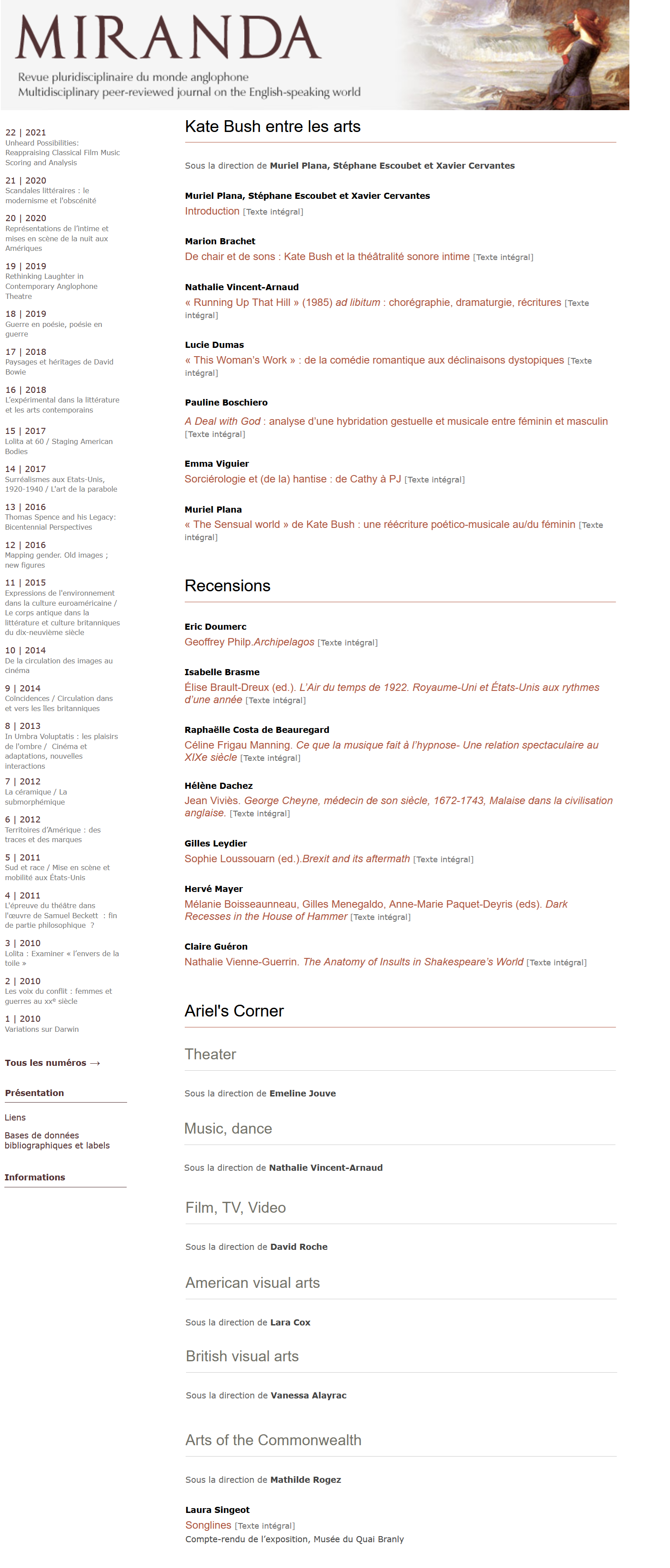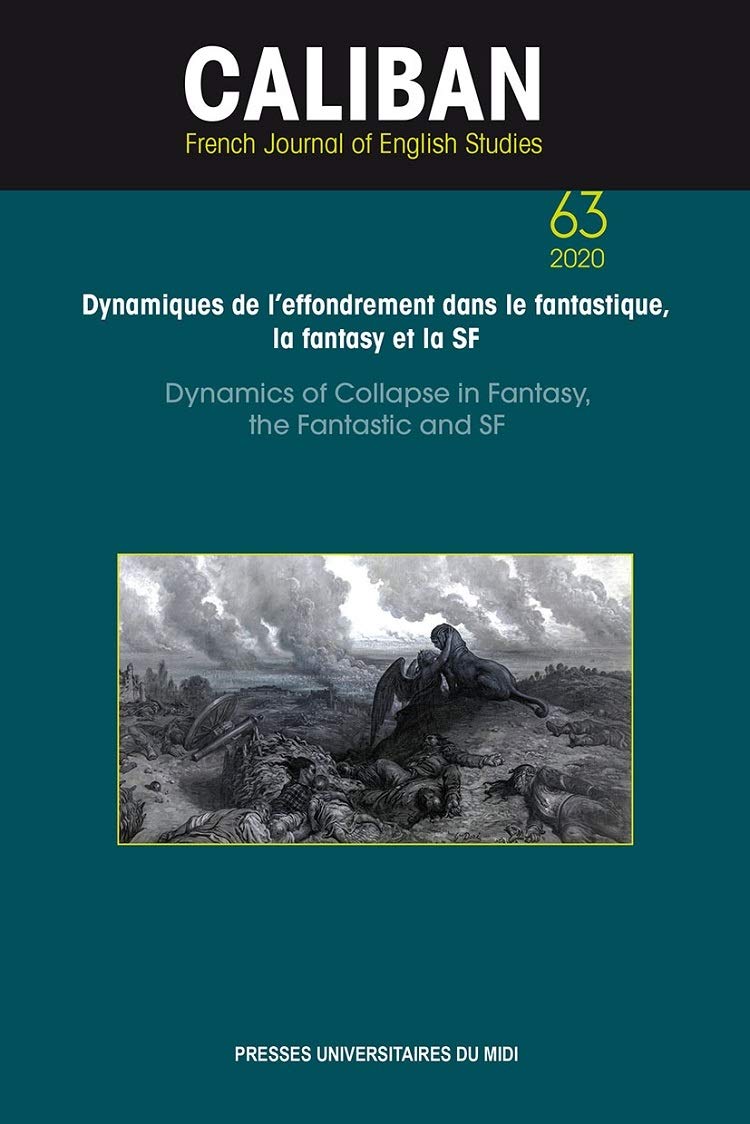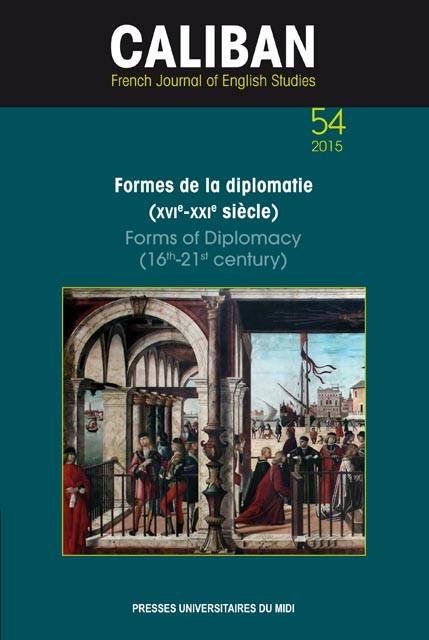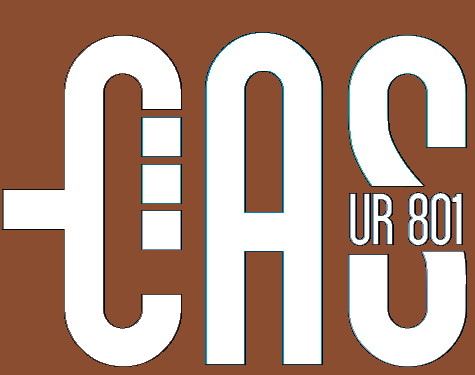MIRANDA
REVUE PLURIDISCIPLINAIRE DU MONDE ANGLOPHONE
MULTIDISCIPLINARY PEER-REVIEWED JOURNAL ON THE ENGLISH-SPEAKING WORLD
Issue 31
The spring 2025 issue of the journal Miranda contains, in the music sub-section (edited by Nathalie Vincent-Arnaud) of its Ariel's Corner section, the second part of my article entitled "Aux sources de la chanson réaliste folk punk de François Hadji-Lazaro : échos d’Irlande, d’Écosse et d’Amérique."
This article explores the diverse influences of folk music from the English-speaking world, from various shades of Americana (especially Cajun music) to the Celtic traditions of Scotland and Ireland, on the eclectic output of multi-instrumentalist punk singer-songwriter
François Hadji-Lazaro, who was the leader of the rock bands
Pigalle,
Les Garçons Bouchers and
Los Carayos in the 1980s and 1990s, a producer through his alternative record label
Boucherie Productions (1985-2001), and who died on February 25, 2023.
The article is, like the rest of the issue, available online at the following address:
https://journals.openedition.org/miranda/66387
MIRANDA
MULTIDISCIPLINARY REVIEW OF THE ENGLISH-SPEAKING WORLD
MULTIDISCIPLINARY PEER-REVIEWED JOURNAL ON THE ENGLISH-SPEAKING WORLD
Issue 29
The spring 2024 issue of the journal Miranda contains, in the music sub-section (edited by Nathalie Vincent-Arnaud) of its Ariel's Corner section, the second part of my second "musical stroll" entitled "Quelques escapades musicales en Bretagne: voyage sans bateau de Belfast à Cardiff en passant par Beyrouth".
(The first part was called "Quelques escapades musicales en Bretagne: voyage sans bateau du Donegal aux Highlands et du pays de Galles aux Asturies", and was published in the previous issue, in autumn 2023.)
Like the first of these "musical strolls" ("Dix jours d'un concert à l'autre à la Nouvelle-Orléans"), it is an experimentation in hybridity between the forms of a research paper (with an apparatus of informative and analytical endnotes based on scientific, journalistic sources, as well as primary sources from the music medium, the video medium, etc.), of more impressionistic criticism, and of a literary text (in the genre of the travel journal/logbook). This time, after New Orleans, the text deals with a musical journey through various places in Brittany, mainly in Lorient, during the town's international Celtic music festival—a journey that took place during the summer of 2023.
The article is, like the rest of the issue, available online at the following address:
https://journals.openedition.org/miranda/59980
MIRANDA
MULTIDISCIPLINARY REVIEW OF THE ENGLISH-SPEAKING WORLD
MULTIDISCIPLINARY PEER-REVIEWED JOURNAL ON THE ENGLISH-SPEAKING WORLD
Issue 28
The autumn 2023 issue of the journal Miranda contains, in the music sub-section (edited by Nathalie Vincent-Arnaud) of its Ariel's Corner section, the first part of my second "musical stroll" entitled "Quelques escapades musicales en Bretagne: voyage sans bateau du Donegal aux Highlands et du pays de Galles aux Asturies".
Like the first of these "musical strolls" ("Dix jours d'un concert à l'autre à la Nouvelle-Orléans"), it is an experimentation in hybridity between the forms of a research paper (with an apparatus of informative and analytical endnotes based on scientific, journalistic sources, as well as primary sources from the music medium, the video medium, etc.), of more impressionistic criticism, and of a literary text (in the genre of the travel journal/logbook). This time, after New Orleans, the text deals with a musical journey through various places in Brittany, mainly in Lorient, during the town's international Celtic music festival—a journey that took place during the summer of 2023.
Unlike the previous one, this second episode of the musical strolls series will itself be published in two parts, the second part being planned for the next issue of Miranda, in spring 2024.
The article is, like the rest of the issue, available online at the following address:
https://journals.openedition.org/miranda/56028
MIRANDA
REVUE PLURIDISCIPLINAIRE DU MONDE ANGLOPHONE
MULTIDISCIPLINARY PEER-REVIEWED JOURNAL ON THE ENGLISH-SPEAKING WORLD
Issue 26
The autumn 2022 issue of the journal Miranda contains, in the music sub-section (edited by Nathalie Vincent-Arnaud) of its Ariel's Corner section, my text entitled "Dix jours d'un concert à l'autre à la Nouvelle-Orléans".
It is an experimentation in hybridity between the forms of a research paper (with an apparatus of informative and analytical endnotes based on scientific, journalistic sources, as well as primary sources from the music medium, the video medium, etc.), of more impressionistic criticism, and of a literary text (in the genre of the travel journal/logbook), this text invites the reader to share with me a musical journey through the clubs, streets, cafes, restaurants and one of the museums of the Crescent City nestled in the hollow of the Mississippi, from jazz to blues to folk to Cajun music and occasional rock, mirroring the similar journey I had the opportunity to experience during the summer of 2022.
The article is, like the rest of the issue, available online, at the following address:
MIRANDA
REVUE PLURIDISCIPLINAIRE DU MONDE ANGLOPHONE
MULTIDISCIPLINARY PEER-REVIEWED JOURNAL ON THE ENGLISH-SPEAKING WORLD
Issue 25
The spring 2022 issue of the journal
Miranda contains, in the music sub-section (edited by
Nathalie Vincent-Arnaud) of its
Ariel's Corner section, my article "« Vienne bientôt l’avitailleur » : viralité fraternelle et musique en ligne en temps de COVID — le cas du ShantyTok".
This new text is a sequel to my previous
Ariel's Corner article "Krakauer-Tagg Duo: du souffle et des marteaux pour abattre les murs du confinement" (on the album
Breath & Hammer by David Krakauer and Kathleen Tagg, its relationship to the covid lockdown context, and to the spread of online music as a tool to create social cohesion). This sequel continues the study of the use of online music to bring together the lockdown-stricken, social distancing-afflicted, COVID-threatened from the English-speaking world. The analysis focuses, this time, on the ShantyTok, which is the name of the early-2021 explosion of viral videos on the social network TikTok (with subsequent uploads and sharing on other social media), devoted to the collective performance of sea shanties by TikTok users. The impacts of the COVID context, of TikTok's mood and how TikTok works, of how virality works, of the rallying properties of sea shanties' musical form, of their escapist cultural content, are examined in parallel to explain this sudden craze of a hyperconnected, anxious and reluctantly isolated youth for the catchy choral singing of hard-at-work Victorian sailors. In doing so, the article makes you travel upon all seas, from that of digital platforms, social networks and online video games, to that of real sailors and that of literary, musical and mythical sailors, from the seas that lie off the coasts of Victoria's Great Britain, and the Ireland and Scotland of folk bands and pubs, to those that lead to the Caribbean and America of the antebellum and Reconstruction periods, up until the sea that passes between the Australia and New Zealand of the whaling days.
The article is, like the rest of the issue, available online at the following address: https://journals.openedition.org/miranda/45765
CALIBAN N°63
DYNAMICS OF COLLAPSE IN
FANTASY, THE FANTASY AND SF
Dynamiques de l'effondrement dans le fantastique, la fantasy et la SF
Collective collection of texts on American, British, Irish, Quebec and Filipino literature and TV series (among others). The main dossier, made up of scholarly articles on the theme of societal and civilizational, environmental, economic and political collapse in works of science fiction, horror and fantasy, was edited by Florent Hébert and myself. It is followed by a section entitled "Detours" which includes reviews, small essays, poems and short stories, which was edited by Helen Goethals and James Gifford, and to which Mr. Hébert and I also contributed. Finally, a section of reviews of scientific works on various themes (edited by Nathalie Rivère de Carles and Emeline Jouve) concludes the collection, and includes a review of mine, which is in line with the themes of the other sections. To be published on 25 February 2021.
Back cover: While a variety of future-set science fiction focusing on the effects of climate change (commonly called "climate fiction" or "cli-fi") is developing, more and more voices are being raised, in the scientific community, no longer to prevent a distant apocalypse, but to take notice of a collapse (of climate, biodiversity, energy resources, hence thermo-industrial civilization) already underway. The purpose of this collection is to accomplish part of the technical and anthropological study of this context offered by theoreticians of systemic collapse, or "collapsologists", but to focus specifically on its impact on fantasy, the fantastic and science fiction. The studies featured in this book are about recent works that may have been influenced by the current context of ongoing collapse and about older works that are then re-read in light of the new context. They provide analyses developed from a collapsological perspective, and reflections on the concept of collapse.
The book's page on its publisher's website:
The whole issue can be read online, at this address:
https://journals.openedition.org/caliban/7118
The collective collection
Caliban 63: Dynamiques de l'effondrement dans le fantastique, la fantasy et la SF/Dynamics of Collapse in Fantasy, the Fantastic and SF, published in
January 2021 and edited by
Florent Hébert and myself, contains, after the thematic dossier of scholarly articles that we edited, a section entitled "Detours", edited by
Helen Goethals and
James Gifford, which includes reviews, small essays, poems and short stories on the same collapsological themes as the preceding scholarly papers. In this section, one can find my book review entitled "On Lionel Shriver's The Mandibles, A Family (2029-2047)".
In this review, I briefly analyze the links of Lionel Shriver's novel to the genres of science fiction, financial crisis fiction and family chronicle, as well as the way in which the novel dramatizes the author's libertarian ideology.
The book's page on its publisher's website:
https://pum.univ-tlse2.fr/produit/n-63-dynamiques-de-leffondrement-dans-le-fantastique-la-fantasy-et-la-sf/
My text, as well as the whole issue, can also be read on line:
https://journals.openedition.org/caliban/7834
Page of the novel
The Mandibles on the site of its publisher:
https://www.harpercollins.com/products/the-mandibles-lionel-shriver?variant=32205656129570
The collective collection
Caliban 63: Dynamiques de l'effondrement dans le fantastique, la fantasy et la SF/ Dynamics of Collapse in Fantasy, the Fantastic and SF, published in
January 2021 and edited by
Florent Hébert and myself, contains, at the end of the issue, a section devoted to reviews of scientific works on various themes, edited by
Nathalie Rivère de Carles and
Emeline Jouve, including
my review of the collective collection
Écrire la catastrophe: L'Angleterre à l'épreuve des éléments (XVIe-XVIIe siècles), edited by
Sophie Chiari and published by the University Press of Blaise Pascal Clermont Ferrand, which offers many analyses of texts from the period studied, sermons, emblematic poems, philosophical treatises, plays by Shakespeare and other authors of the time, or accounts of explorers' travels, thus forming a cultural panorama that shows the evolution from a vision of natural disasters as divine punishment, towards a progressively better understanding of the climate and meteorological issues related to these phenomena.
The book's page on its publisher's website:
https://pum.univ-tlse2.fr/produit/n-63-dynamiques-de-leffondrement-dans-le-fantastique-la-fantasy-et-la-sf/
My text, as well as the rest of the issue, can also be read on line: https://journals.openedition.org/caliban/8300
Page of the book
Écrire la catastrophe on the site of its publisher:
http://pubp.univ-bpclermont.fr/public/Fiche_produit.php?titre=%C3%89crire%20la%20catastrophe
MIRANDA
REVUE PLURIDISCIPLINAIRE DU MONDE ANGLOPHONE
MULTIDISCIPLINARY PEER-REVIEWED JOURNAL ON THE ENGLISH-SPEAKING WORLD
Issue 21
The autumn 2020 issue of the journal
Miranda contains, in the music sub-section (edited by
Nathalie Vincent-Arnaud) of its
Ariel's Corner section, my article "Krakauer-Tagg Duo: du souffle et des marteaux pour abattre les murs du confinement".
The article examines
Breath & Hammer, an album by New York-based klezmer and jazz clarinetist David Krakauer and South African classical and experimental pianist Kathleen Tagg, released on May 8, 2020, during the first period of lockdowns related to the COVID-19 pandemic. The purpose of this study is to show how the warm and radically composite character of the album and its rhetoric of rapprochement between cultures work to form both a culmination of the explorations of sound and mood found in the respective careers of the two musicians, and an imaginary that is apt to counter that of extreme loneliness bred by lockdowns and social distancing.
While the eponymous show was accompanied by a video installation which extended its musical message in favour of ties and sharing, the album also got, at the time of its release, an audiovisual extension. Indeed, as they were denied a promotional tour because of the lockdown, Krakauer and Tagg embarked on the production of a weekly web-show hosted from home, with concerts given from their apartment, videoconference interviews with their friends and collaborators, extracts from video archives of concerts and interviews... All that works as extra features to the release of the album, enthusiastically guiding viewers through the two artists' eclectic, multicultural and musically adventurous universe. The article also analyses those
Krakauer & Tagg's Sunday Connections. It shows how this series of videos adds to the spirit of connection through music promoted by the album, and how it is part of a widespread increase of the sharing of music, via the Internet or from balcony to balcony, during that period of isolation.
The article can be read online at the following address:
https://journals.openedition.org/miranda/28782
Interroger l'intersémioticité
FORMS OF DIPLOMACY (16th-21st CENTURY)
Formes de la diplomatie (XVIe-XXIe siècle)
ART ET LITTERATURE FANTASTIQUES
N°27-28
Forêts fantastiques

















